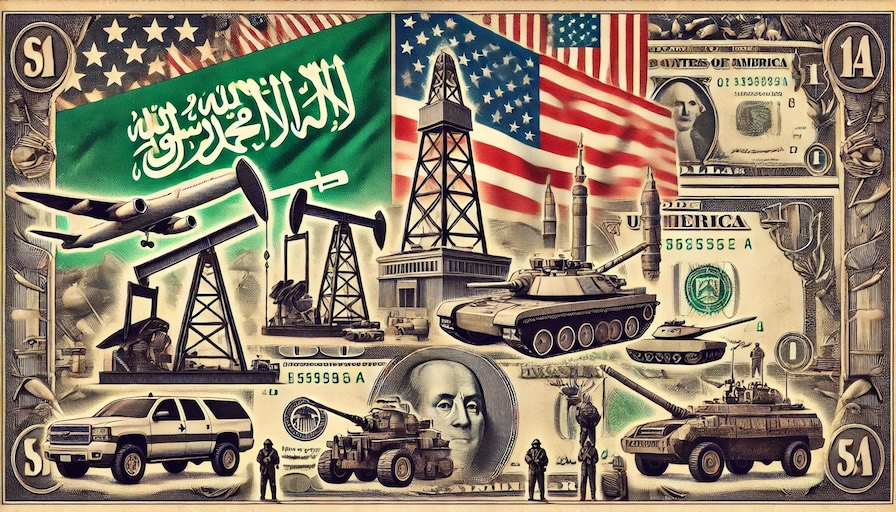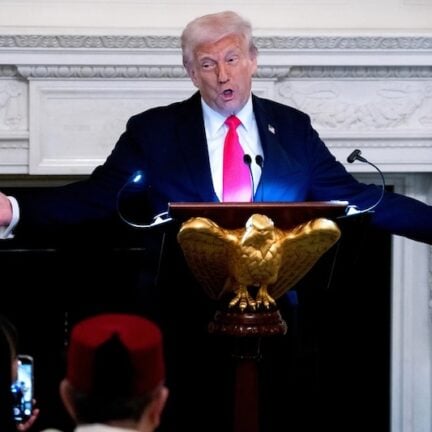Question:
Al-Hurra website published, 18/6/2024: (Recently, news sites have widely circulated reports talking about a Saudi-American Agreement in 1974, under which Saudi Arabia would use the dollar in all its oil sales. According to those reports, this agreement and its duration of 50 years, is now over… but the Leader Insight website refuted those reports, stressing, “There is no such agreement”). I would like clarity on the truth of this agreement, if it exists, and the role of oil in maintaining the dominance of the dollar. And will the BRICS bloc affect the dominance of the dollar in the future?
Answer:
In order to clarify the answers to the above questions, we review the following matters:
First: In terms of the news circulating about the expiration of the term of the Saudi-American Agreement to limit the sale of oil to dollars, the social media sites are swarming with the news, but no official statement from the two countries spoke about this, as if they deliberately left it ambiguous! As for the media, they refrained from circulating it at first, then some started talking about it due to the large amount of talk about it. For example, the Russian RT website, published on 15/6/2024 (Olga Samofalova wrote in Vzglyad: “The petrodollar agreement between the Kingdom of Saudi Arabia and the United States, which was signed in 1974, has expired. This allows Saudi Arabia to sell its oil and other products not only in US dollars, but also in other currencies, as the media confirms). This is an unofficial confirmation from a Russian media source about the existence of such an agreement.
Second: However American media sources deny this matter:
1- What was stated in the question on the Al-Hurra website, 18/6/2024: (…According to those reports, this agreement, which lasted 50 years, has now ended, which heralds the end of the dominance of the American currency. But the Leader Insight website refuted the reports, on Monday, confirming: “there is no such agreement”).
2- Morning Star Newspaper, 17/6/2024, addressed the stories spreading across social media sites about the collapse of the long-term petrodollar agreement between America and Saudi Arabia, and said, “This agreement never existed”.
3- In a blog post on Friday, Paul Donovan, chief economist at UBS Global Wealth Management, noted that [the fake “petrodollar deal” story has become surprisingly widespread, providing another lesson about the dangers of “confirmation bias.” (Morning Star, 17/6/2024)].
Third: However, neither side officially commented on the recent articles stating that the petrodollar agreement concluded between the United States and Saudi Arabia in 1974 had expired on 9/6/2024. Neither side officially commented in denial or confirmation, but rather the comments were from other media sources or something similar! As we showed above, there are other signs through which it is likely that there is an agreement in this regard between America and Saudi Arabia, and these signs include the following:
1- It was stated in the report of the Comptroller General in America issued in 1978 entitled “The American-Saudi Committee for Economic Cooperation”: (The Comptroller General recommends strengthening the work of the Saudi-American Committee for Economic Cooperation, which was established in June 1974, and opening an office for the US Department of the Treasury in Riyadh to “recycle petrodollar”). The report confirms in its introduction the establishment of this joint committee.
2- After Paul Donovan said in his blog post that [“It is clear that the story of the “petrodollar agreement” that is circulating today is fake news,” he added, “Perhaps the closest thing to a petrodollar deal was the secret agreement between the United States and the Kingdom of Saudi Arabia that was reached in late 1974, which promised to provide aid and military equipment in exchange for the Kingdom investing billions of dollars from the proceeds of the sale of oil in the US Treasury” (Morning Star, 17/6/2024)].
3- After the Morning Star Newspaper reported, on 17/6/2024, that the petrodollar agreement between America and Saudi Arabia, “this agreement never existed,” it said, “Based on a report published by the American Accounting Office, the matter relates to a joint American-Saudi committee that was established to enhance the economic cooperation between the two countries and the decision to establish it was signed on 8/6/1974 between US Secretary of State Kissinger and the Saudi Crown Prince at the time, Fahd bin Abdulaziz”.
4- On 20/10/2020, the Kuwaiti newspaper Al-Qabas published in its “News Archive” a news item that it had published in the June 7, 1974 issue, in which it stated the following: (President Nixon discussed today with Prince Fahd bin Abdulaziz, Second Deputy Prime Minister of Saudi Arabia and Minister of Interior discussed the possibilities of achieving lasting peace in the Middle East in the wake of the agreements to separate forces on the Egyptian and Syrian fronts with ‘Israel’. They also discussed ways to expand economic, industrial and defense cooperation between the Kingdom of Saudi Arabia and the United States. Their talks took place in President Nixon’s office in the White House before a luncheon held by the American President at the White House in honor of his guest, who arrived here yesterday for a three-day visit. He stated that prince Fahd seeks to increase American military assistance to his country in exchange for continued Saudi cooperation in supplying the United States with oil).
5- businesstimes.com.sg reported on 18/6/2024: [On 8/6/1974, the American newspaper, The New York Times reported, on its front page: (Secretary of State Kissinger and Prince Fahd Ibn Abdel Aziz, Second Deputy Premier of Saudi Arabia and a half‐brother of King Faisal, signed the six‐page agreement at Blair House across the street from the White House this morning.)].
Fourth: Taking a closer look at the third point above, especially US President Nixon’s reception of Fahd bin Abdulaziz, indicates the great importance of that visit. As well as, the establishment of the American-Saudi Committee for Economic Cooperation on 8/6/1974, which is referred to by official sources, including the report of the American Comptroller General, indicates that there were agreements that were concluded as if this committee was in charge of their implementation, and all of this confirms the existence of an agreement between America and Saudi Arabia, whether it was written and kept secret or were binding and unwritten understandings. Even such understandings between a small agent state and the most powerful state, America, are completely binding on the agent, they do not deviate from it even if it is not written.
All of the above facts support what we believe is the reality of the existence of this agreement or petrodollar understanding, even though this remains secret and is not recognized by official circles, but they do not deny it either.
Fifth: What confirms or suggests this is America’s interest in making the dollar the international currency of the world, this is how:
1- Since the Bretton Woods Agreement in 1944, which set the price of an ounce of gold at $35, the dollar has become at the highest level of the global monetary system. The same as gold, but because of America’s colonial projects, especially the Vietnam War, and the exorbitant spending on the war, the United States has printed more dollars more that what can be exchanged for gold. By the late 1960s, the number of dollars in circulation had increased, and there were more dollars in the world than gold. This encouraged foreign countries to demand gold in exchange for their dollars, which led to the depletion of American gold supplies. The US gold reserve decreased from 574 million ounces at the end of World War II to about 261 million ounces in 1971. Then US President Richard Nixon abolished the gold standard on 15/8/1971, thus completely separating the dollar from gold, in what was known as the ‘Nixon Shock’.
2- However, this separation between the dollar and gold created a political and financial problem for America, which is that countries in the world no longer have any motive to obtain dollars, and this made America look for other means that push countries to increase the demand for the dollar, thus preserving the dollar’s global status. America found the answer in the world’s urgent need for energy and therefore the main source of energy represented by oil, of which Saudi Arabia was the largest producer at the time.
3- The Nixon administration dealt with this through discussions with Saudi Arabia from 1972 to 1974 to establish the petrodollar, and then the agreement that stipulated that the United States would provide a security guarantee to the Saudi regime, and in return Saudi Arabia, the largest oil producer in the world, which possesses the largest reserves oil revenues in the world, by selling its oil in dollars, and Saudi Arabia also agreed to recycle billions of US dollars from its oil revenues into US treasury bonds.
4- Before this agreement, Saudi Arabia used to deal in British pounds in exchange for oil, due to the influence of British agents in ruling Saudi Arabia at that time. When this agreement was concluded on 8 June 1974 between Secretary of State Kissinger and Prince Fahd bin Abdulaziz, it was a prelude to dealing in dollars with Saudi Arabia instead of sterling as the price of oil.
After that, prince Fahd rose to prominence and became crown prince in 1975, during the reign of his brother, King Khalid. He had most of the powers during the reign of his brother, King Khalid, and he continued to do so until King Khaled’s death and he became king on June 13, 1982. He was known for his loyalty to America.
Thus, Saudi Arabia’s dealings with the price of oil were limited to dollars starting from the beginning of 1975, as sources state that after 1974, Saudi Arabia’s sale of oil was limited to US dollars, and this also included OPEC to oil-producing countries, and it became mandatory for every country that needed to buy oil to have a sufficient amount of dollar currency, which was the only currency used in oil transactions, which means that these countries must accept loans in dollars or buy dollars from financial markets, or by any other means. The important thing is that America guaranteed the continued flow of the dollar, and the Federal Reserve Bank guaranteed the continued production of the dollar… especially since the Saudi riyal is linked to the dollar, and therefore there is an incentive for Saudi Arabia to commit to the US dollar to maintain economic stability. [“Saudi Energy Minister Khalid Al-Falih confirmed that the US dollar will remain the approved currency for sales and trade of his country’s crude oil abroad…” (Anadolu 9/4/2019)].
Sixth: If Saudi Arabia’s accession to the BRICS bloc led by China and Russia, who are America’s opponents, affects Saudi Arabia’s continued restriction of the pricing of its oil in dollars, then this issue is affected by other factors. To clarify this, we review the following:
1- The term BRICS is used to refer to the economies of Brazil, Russia, India, China and South Africa. Brazil, Russia, India and China formed the BRIC group in 2006 in order to give developing countries a greater role in international affairs. In 2011, the group’s name was changed to BRICS with the addition of South Africa. It was announced that Saudi Arabia, along with Egypt, the Emirates, Iran, Ethiopia, and Argentina, would be included in BRICS at the G15 Summit, which was concluded on 24 August 2023 in Johannesburg, the capital of South Africa. These countries would join at the beginning of 2024. One of the goals of this summit was to try to get rid of the dominance of the dollar and issue a currency for the BRICS members, but these countries did not agree on that. It sought to encourage dealing in its local currencies among them. That is why it worked to invite Saudi Arabia, the largest oil exporter, to the group. It is worth noting that despite the official Sauditelevision announcement on 2 January 2024 that Saudi Arabia had joined the BRICS, Saudi Trade Minister Majid Al-Qasabi said in a panel discussion on the sidelines of the World Economic Forum in Davos, Switzerland: [“Saudi Arabia received an invitation to join BRICS, but we did not join officially yet.” (Sky News Arabic 16/1/2024)]. This means that Saudi Arabia was waiting for America’s approval to join BRICS so that its accession would be in America’s interests.
2- The entry of countries affiliated with America, such as Saudi Arabia, into the BRICS group makes this group fragile, and we have seen South Africa’s opposition to issuing a currency for the BRICS. There are no independent countries in the BRICS group except Russia and China, and the rest are agents of the West, especially America. But Russia and China want to appear as if they were able to confront the West and form a counter front, and they always talk about a multipolar world. When America allows Saudi Arabia and other of its agents to enter BRICS, it is in order to influence it from within, just as it previously encouraged its Eastern European affiliated countries to enter the European Union in 2004 to influence it through these countries. Through Poland, which entered the union, it was able to obstruct the drafting of a constitution for it to strengthen its political power and bring it closer to a quasi-federal state, keeping it a fragile union that is vulnerable to fracture and collapse. This is what happened when it tasked Saudi Arabia, which is the largest producer in OPEC and has a strong influence on it, with actively using the necessary methods to create an alliance of some kind between OPEC and Russia to control Russia’s production within OPEC’s limits, in coordination between Saudi Arabia and Russia.
3- And Putin, whose country is a founding member of the group, who is very enthusiastic about issuing a currency for the group, has surrendered to the political reality of the member states and said: “Continuing to expand BRICS would activate the role of the bloc at the international level, and the issue of adopting a unified currency is still complex and needs more discussions.” (Al Jazeera, 24/8/023). Al Jazeera had previously published on 23/8/2023: (The issue of the unified currency of the BRICS group was not formally raised during the summit due to the lack of agreement among the five members and the existence of discrepancies between them… Putin called in a speech via video directed to the group to expand dealing in local currencies…) Thus, Russia did not succeed in finding an alternative currency to the dollar, which is what it wanted to achieve from BRICS.
Seventh: As long as currency is paper, it has no intrinsic value, and the economic problems, economic speculation, political disputes, and even colonial domination will exist. Islam, through the Revelation of Allah (swt), gold and silver were made the basis of money, that is, a material that carries intrinsic value. The Messenger (saw) made gold and silver the currency, and he (saw) made them alone the monetary standard to which goods and efforts are measured, as proven in authentic Hadiths. But the colonizers, using the methods of economic colonialism and financial colonialism, used currency as a means of colonialism, so they converted currency to other systems that were not based on gold or silver, and thus giving rise to these problems. These problems cannot go away unless the Islamic state is established and returns money to gold and silver, whether they are used in circulation, or there is paper money in circulation replacing gold and silver and replacing them at all times. This is the Shariah of Allah (swt) that He revealed with His Knowledge,
[أَلَا يَعْلَمُ مَنْ خَلَقَ وَهُوَ اللَّطِيفُ الْخَبِيرُ]“Does He who created not know, while He is the Subtle, the Aware?” [Al-Mulk: 14]
1 Muharram 1446 AH
7/7/2024 CE













